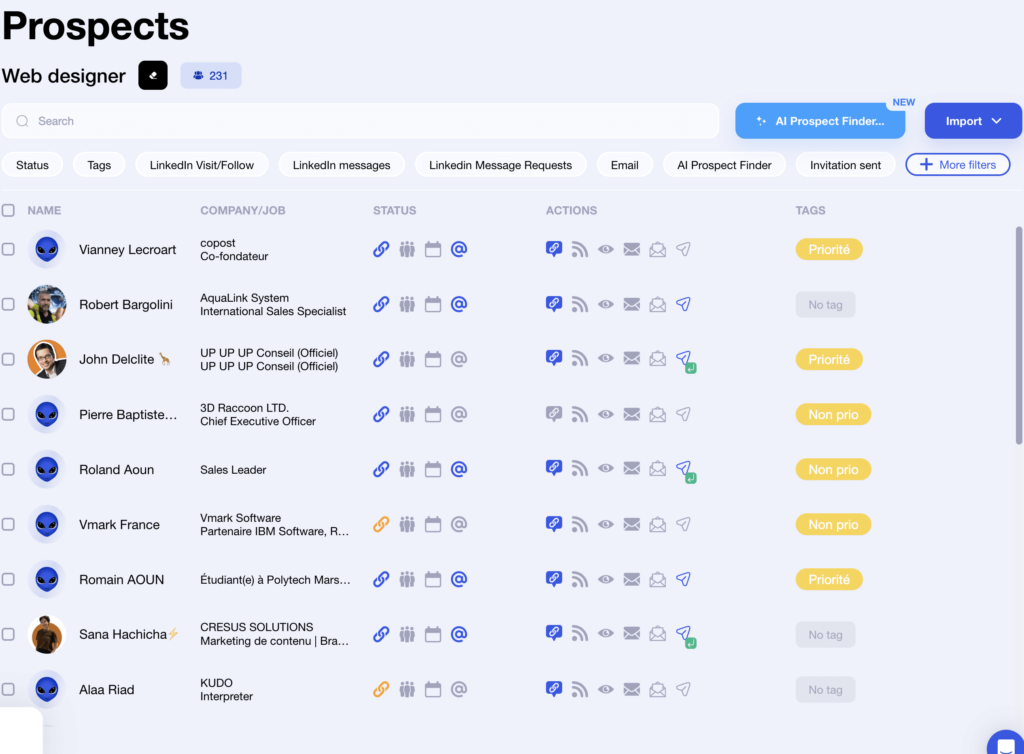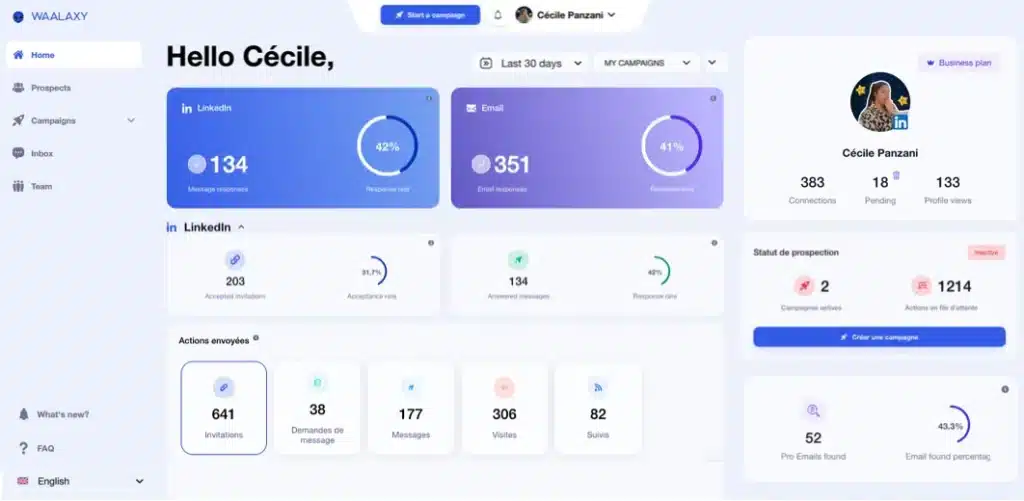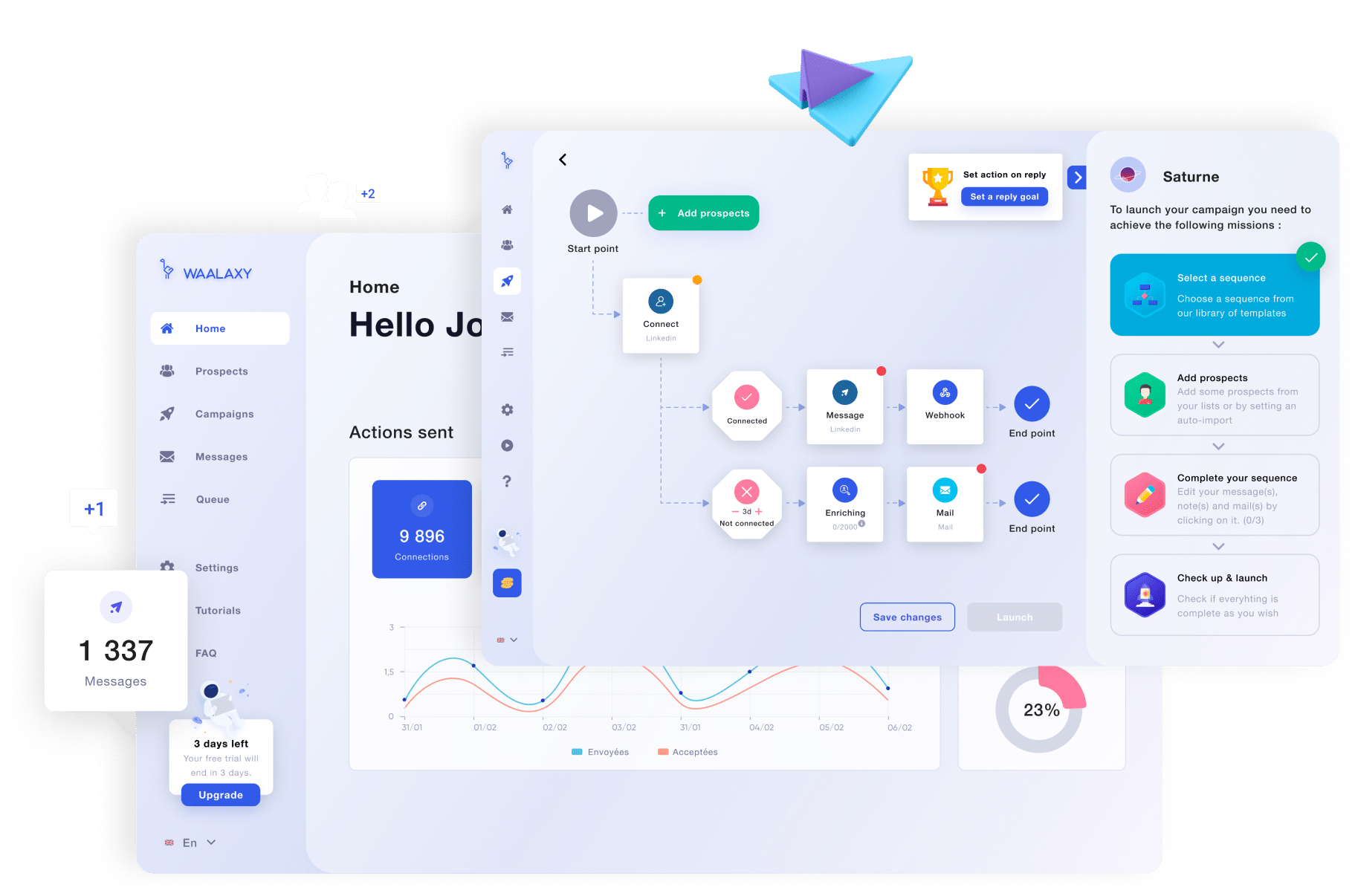Does web scraping and data scraping sound familiar? 🤔 If you’ve heard of these terms, but don’t really know what they entail, you’ve come to the right place! 🌐 These techniques make it possible to extract valuable data from the internet, like a digital detective looking for hidden info. 🕵️♂️
In this article, we’ll explain what it is and show you 5 great tools to get started. Ready to dive into the world of scraping? Let’s go!
What is web scraping and data scraping?
Before diving into concrete applications, let’s start by laying the groundwork: what exactly do web scraping and data scraping mean? These two techniques are often confused, but they have distinctive features that deserve to be clarified.👀
Web scraping is a bit like sending a virtual assistant to rummage around the Internet for specific information ✨ For example, let’s say you run an online store and want to track your competitors’ prices. Web scraping will automate this work by collecting data directly from the websites concerned.
In practice, it’s a process that extracts and structures information visible on the web, such as product listings, customer reviews, schedules, or even publications. 🔢
Data scraping is a broader concept. This technique is not limited to extracting data from the Internet. It also encompasses the collection of information from other digital sources, such as local files (CSV, Excel) or databases. 📊
Where web scraping focuses on the web, data scraping targets all accessible digital data, whatever its origin.
These two methods have become indispensable in many fields, whether for analyzing trends, optimizing business processes, or automating repetitive tasks. And the best part? They save an incredible amount of time and allow you to work much more efficiently. 🚀
What are the advantages of web scraping and data scraping?
Web scraping and data scraping are not just trendy techniques, but real assets for improving your efficiency and saving time. If you’re still hesitating to get started, here’s why these methods are indispensable for many professionals today.🤩
1. Top competitive intelligence
In an increasingly competitive world, knowing what your competitors are doing in real time can make all the difference. With web scraping, you can automate the collection of information from their websites:
- Their marketing strategies. 😎
- Their new products.🛍️
- Their prices 💸
- Their promotions.♻️
This enables you to react quickly to market changes and adjust your own actions to stay competitive. Competitive intelligence becomes child’s play, just a click away. 📊
2. Simplified market analysis
Having a clear and comprehensive view of your market is essential to making informed decisions. Web scraping enables you to collect data from multiple online sources: forums, blogs, social networks, specialized sites… This way, you can parse industry trends, spot emerging consumer needs and even track customer reviews. 🛍️
Rather than spending hours gathering information, you can now get detailed reports in record time. This helps you better understand your audience and adjust your offer accordingly.🤓
3. Automation of repetitive tasks
Scraping helps you automate difficult, repetitive tasks, such as collecting information from different sites, creating prospecting files or updating databases. 🕒
Rather than spending hours manually retrieving data, you can let a scraping tool do the work for you, seamlessly and without errors. 😇
This frees up your time to concentrate on higher value-added tasks, while guaranteeing accurate and consistent data extraction. Incredible productivity gains!
4. Cost-effective solutions
Scraping is a cost-effective and accessible way of collecting databases, even for small businesses or freelancers. Many scraping tools are free or offer affordable versions. 💰
Rather than relying on consultants or costly external services to obtain market information, you can use scraping solutions to collect this data yourself. You benefit from real-time data without having to break your budget. 💰
5. Data security
One of the most frequently discussed issues in scraping is the question of security and legality. By using scraping tools that respect standards and best practices, you can collect public data without compromising the security of your information. 🔒
What’s more, some scraping solutions incorporate advanced technologies to guarantee the confidentiality and protection of extracted data, such as Waalaxy or Phantom Buster. By choosing the right tools, you ensure not only the compliance of your approach, but also the security of the data collected.😎
What are the challenges of web scraping?
Web scraping and data scraping are all very well, but they’re not always smooth sailing. These techniques come with their own set of challenges that you should be aware of before you start. Here are the main pitfalls and how to overcome them 🥹
1. Technical challenges
Let’s get one thing straight: scraping isn’t always child’s play. 🛠️ Websites are constantly evolving, with complex designs, dynamic structures (thanks JavaScript 😅), and sometimes anti-scraping protections. You may need to juggle specific tools or even develop custom solutions to get around these technical hurdles. Fortunately, there are plenty of frameworks and no-code tools (like Waalaxy) to make your life easier! 🙌🏻
2. The legal framework
Web scraping often raises legal issues, and it’s essential to respect the legal framework. Even if you’re collecting public data, that doesn’t mean you can use it as you see fit. ⚖️
Some sites explicitly forbid scraping in their terms and conditions. Before you start, it’s best to check whether you’re in compliance to avoid potential problems. Tip: stick to publicly accessible data(RGPD in Europe) and use it for ethical purposes!👀
3. Protected sites
Some sites aren’t big fans of scraping, and they put in place safeguards to prevent the extraction of their data. 🛡️ Captcha, IP restrictions, or advanced detection systems: these are just some of the barriers you might encounter. 😥
To get around these obstacles, there are solutions such as using proxies or specialized services. But beware: don’t insist too much on protected sites, as this may be perceived as an infringement of their rules.😥
A proxy is like an intermediary between you and the Internet: it masks your IP address to keep your browsing private. 🌐 Super useful for bypassing restrictions, protecting your data or even scraping sites without getting blocked! 🚀
How do you achieve effective data scraping without coding?
Think data scraping is just for programming experts? Good news: it’s not! With no-code tools, anyone can get started, even without a line of code. 👩🏻💻
Why opt for no-code?
No-code solutions are ideal for getting started quickly in data scraping, even if you have no technical skills. 🎯 Here are their main advantages:
- It ‘s simpler: no need to master HTML, Python or JavaScript, everything is done via intuitive interfaces.😍
- It’s fast: in just a few clicks, you set up your extractions and get your data.📊
- It’s accessible to your entire team: No need for a dedicated developer. Marketers, analysts or product managers can easily use it.👭
➡️ Here are a few tips for successful scraping:
- Identify reliable and accessible sources.
Before you start, list the sites or platforms where you can find the data you need. 🌐 Opt for reliable sources that allow free access to public information to avoid any legal or technical problems, for example, LinkedIn.✨ - Understand output formats.
When you scrape data, you can export it in different formats such as CSV, JSON or Excel. 📁 Before you start, think about which one best suits your needs. For example, CSV is perfect for analyses in Excel, while JSON is ideal for more technical tools like a CRM. - Familiarize yourself with technical limitations.
Even in no-code, it’s important to be aware of the technical challenges:- Captchas (those famous tests «I’m not a robot») can block your attempts.🤖
- IP address blocks can occur if you scramble too quickly.🚫
- Some sites are simply protected against scraping.🛡️
What data can we scrape?
The web is a goldmine! With data scraping, you can extract all kinds of data, but beware: not everything that’s technically feasible is legal. Here’s an overview of the data you can scrape (within the rules, of course!). 🚀
1. Structured data
These are the well-organized, super-easy-to-extract data, such as :
- Price tables : Want to keep an eye on your competitors’ prices? Scraping their offers can help you adjust yours and stay competitive. 🛒
- Customer feedback: User feedback on products or services is invaluable for analyzing marketing trends, identifying areas for improvement and anticipating consumer expectations. ⭐
- Listings and directories: Retrieve information on companies, events, or products from public directories, ideal for enriching your databases or preparing targeted campaigns. 📋
This data is ideal for software such as BeautifulSoup, which simplifies the task by automating the extraction of information.
2. Unstructured data
It’s a bit of a mess here! This data isn’t well organized, but it’s packed with interesting info:
- Text: Blogs, product descriptions, forums… This content is perfect for analyzing keywords, spotting recurring themes or understanding users’ opinions on a specific topic. ✍️
- Images: Ideal for studies on visual trends, such as fashion, design, or even product recognition. With the right data, you can spot popular styles or track the evolution of a sector. 📸
- Metadata : Hidden info on web pages, such as SEO tags, descriptions, urls or technical information, which is essential for optimizing your online strategy or auditing a site. 🔍
These data sometimes require a little more processing, but they offer more information once exploited. 💡
3. Emails and professional contacts LinkedIn
Need to expand your network or prospect effectively? Waalaxy is the web scraping tool you need to exploit the full potential of LinkedIn! 🚀
➡️ What you can do with Waalaxy :
- Scrape public information on LinkedIn: names, positions, companies, even profile emails thanks to the Email Finder. 📊
- Retrieve secure emails: thanks to its integration with Dropcontact, collected emails are enriched and validated in compliance with the RGPD. ✅
- Manage your data easily: Waalaxy organizes all collected information for clear tracking. 🗂️

- Automate your campaigns: Send personalized messages via LinkedIn or email without manual effort. 📧
- Connect to your CRM: Integrate your leads directly into your favorite CRM for centralized management. 🔗
- Track your performance: Analyze your prospecting campaigns to optimize them and maximize your results. 📈

4. Social network data
Social networks are a treasure trove of information! 🌟 They’re overflowing with public data on companies and professionals: names, positions, locations, or even recent publications. And good news: you can scrape it all easily with tools like Waalaxy (LinkedIn) or Apify (Facebook, Instagram and Twitter). 🎉
➡️ For example, you can scrape :
- Popular hashtags and mentions 🔥: Find out what’s trending in your field to stay current or adapt your social media strategy.
- Interactions on publications 💬: Analyze who comments, shares or likes to better understand your target audience.
➡️ Scrapping social networks helps you :
- 🎯 Target your prospects: Quickly find the right people to contact.
- 🚀 Adapt your offers: Identify market needs thanks to signals from companies or users.
- 🛠️ Personalize your campaigns: Build prospecting messages and strategies that are truly adapted to your target.
A recap of web scraping and data scraping
And there you have it, you’re now ready to explore the world of web scraping and data scraping! 🚀 These techniques can be real game changers for you, whether you’re a marketer, entrepreneur or data professional. Thanks to them, you can collect and analyze info faster and much more efficiently. 🤓
➡️ To sum up, here are the main advantages of web scraping:
- Competitive intelligence: Stay on top of what your competitors are doing to adjust your strategies in real time. 🧐
- Market analysis : collect data to better understand your audience and spot trends, and do your market research. 📊
- Task automation: Say goodbye to repetitive tasks and free up time for more strategic actions. ⏳
- Cost-effective solution : affordable tools, even for small businesses, without breaking the bank. 💸
- Data security: collect data safely, while complying with legislation. 🔒
Of course, always bear in mind the importance of respecting the law and acting ethically. ⚖️ And to get started, you can try out tools like Waalaxy to make your job easier! 🎯
Frequently asked questions
Is web scraping legal?
The legality of web scraping depends on several factors: the laws, the type of data collected (such as personal data …), and the rules set by the websites themselves. ✨
➡️ As a general rule :
- Public data: Extracting publicly available data, such as prices or customer reviews, is generally allowed, especially if you use it for non-commercial purposes. 👍
- Protected data: if data is password-protected or requires authentication (such as user accounts), scraping it may be considered a breach of privacy or an offence under certain laws. 🚫
- Copyright and intellectual property: Copying copyrighted content (text, images, videos) for republication without permission is illegal. 🚨
How do you know if you can scrape a website?
There are several steps to follow to determine if you can scrape a website legally and effectively:
- Read the site’s terms and conditions: The terms and conditions of use of many sites specify whether scraping is authorized or prohibited. If the T&Cs mention a ban, scraping this site could expose you to penalties. 📜
- Check the robots.txt file: Websites sometimes use a file called robots.txt, accessible by typing “sitename.com/robots.txt” in the address bar. This file tells you which parts of the site are accessible or forbidden to robots (such as those used by search engines or web scrapers). Please note, however, that this is a guideline, not a legal obligation. Following it is good practice, but it’s not an absolute rule. 🤖
- Observe technical protections: Some sites set up barriers to prevent scraping, such as :
- CAPTCHAs (those famous « I’m not a bot » 🤖 tests).
- IP blocks if you make too many requests quickly. 🚫
- Dynamic structures (JavaScript, Ajax) that make data harder to extract. 💻 If a site has these protections, it’s probably because it doesn’t want to be scrapped. 🚧
- Ask for authorization: If you have any doubts or need specific data, contact the site to ask for explicit authorization. Some companies even offer API to collect data legally. 📧
Even if a site seems technically accessible, that doesn’t mean you have the right to extract data from it. It’s always best to check before you start. ✔️
Data scraping now has no secrets for you! ✨








